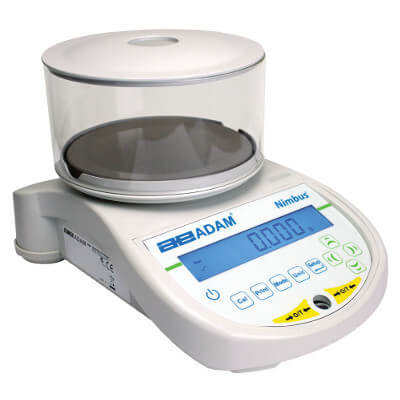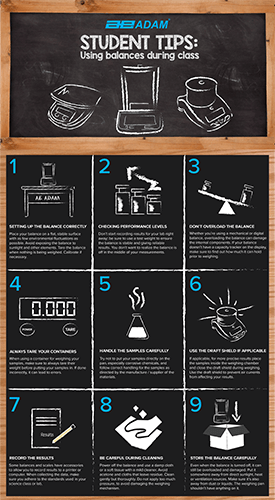Depending on the level and the complexity of the class, students can use anything from mechanical triple beam balances to semi-micro digital lab balances. No matter what type, the balances are an investment for the schools. Here are some tips that can help both teachers and students ensure the balances will maintain optimal performance for many years.
1) Make sure the balance is set up correctly
Whether you’re in class or performing a field experiment, you must put the balance on a flat, stable surface, with as few environmental fluctuations as possible. If you’re in the field, avoid exposing the balance to the elements. In class, avoid direct sunlight and ventilation. Verify that the balance is at zero when nothing is being weighed. Calibrate if necessary. For triple beam balance users, look at our helpful video on the correct calibration method.
2) Check the balance’s performance before measuring
Don’t start recording results for your lab right away; be sure to use a test weight to ensure the balance is stable and giving reliable results. You don’t want to realize the balance is off in the middle of your measurements.

3) Don’t overload the balance
No matter how tempting, do not put your backpack or heavy textbooks on the balance. It doesn’t matter whether you’re using a mechanical balance or a digital one. Overloading the balance can damage the internal components. If your balance doesn’t have a capacity tracker on the display, make sure to find out how much it can weigh first.
4) Always tare your containers
When using a container for weighing your samples make sure to always tare their weight before putting your samples in. If done incorrectly it can lead to errors.
5) Handle the samples carefully
Try not to put your samples directly on the pan, especially corrosive chemicals, and follow correct handling for the samples as directed by the manufacture / supplier of the materials.

6) Use the draft shield or weighing chamber if applicable
For more precise results, if you balances comes with a draft shield, place the samples inside the weighing chamber and close the door or the shield during weighing. If you’re in the field, make sure to use the draft shield to prevent air currents from affecting your results.
7) Don’t forget to record the results
Some balances and scales have accessories to allow you to record results to a printer or computer. When collecting the data, make sure you adhere to the standards used in your science class or lab.
8) Be careful during cleaning
If you have to clean the balance, turn it off. Use a damp cloth or a soft tissue with a mild cleaner. Avoid acetone and cloth or tissue that can leave residue. Clean gently but thoroughly. Do not apply to much pressure, or you might damage the weighing mechanism.

9) Store the balance carefully
Even when the balance is turned off, it can still be overloaded and damaged. Put it somewhere away from direct sunlight, heat or ventilation sources. Make sure it’s also away from dust or liquids. The weighing pan shouldn’t have anything on it.
If you have any further questions about how Adam educational weighing scales and balances can help you then please contact. Download a PDF version the Adam student tips guide online today!


